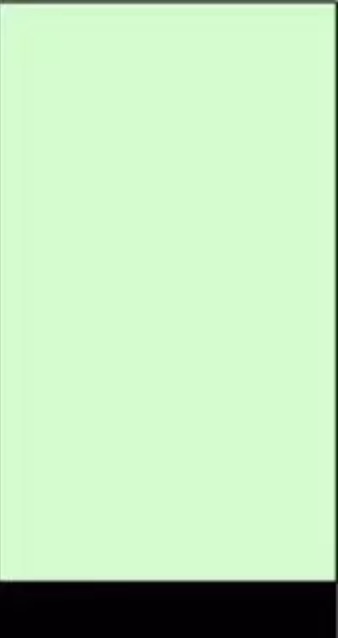现在,市面上的屏幕尺寸和全面屏方案五花八门。这里我使用了小米的图来说明:

上述两种屏幕都可以统称为刘海屏,不过对于右侧较小的刘海,业界一般称为水滴屏或美人尖。为便于说明,后文提到的「刘海屏」「刘海区」都同时指代上图两种屏幕。
刘海屏、水滴屏全面屏适配细节
当我们在谈屏幕适配时,我们具体谈什么呢?
其中第一点是所有应用都需要适配的,对应下文的声明最大长宽比,而第二点,如果应用本身不需要全屏显示或使用沉浸式状态栏,是不需要适配的。
针对需要适配第二点的应用,需要获取刘海的位置和宽高,然后将显示内容避开即可。
声明最大长宽比
以前的普通屏长宽比为16:9,全面屏手机的屏幕长宽比增大了很多,如果不适配的话就会类似下面这样:

适配方式
适配方式有两种:
这个操作将会为<application> 标签隐式添加一个属性,android:resizeableActivity="true", 该属性的作用后面将详细说明。
在 <application> 标签中增加属性:android:resizeableActivity="false",同时在节点下增加一个meta-data标签:
<!-- Render on full screen up to screen aspect ratio of 2.4 --> <!-- Use a letterbox on screens larger than 2.4 --> <meta-data android:name="android.max_aspect" android:value="2.4" />
原理说明
在 Android 7.0(API 级别 24)或更高版本的应用,android:resizeableActivity属性默认为true(对应适配方式1)。这个属性是控制多窗口显示的,决定当前的应用或者Activity是否支持多窗口。
可以在清单的<activity>或 <application>节点中设置该属性,启用或禁用多窗口显示,配置如下:
android:resizeableActivity=["true" | "false"]
如果该属性设置为 true,Activity 将能以分屏和自由形状模式启动。 如果此属性设置为 false,Activity 将不支持多窗口模式。 如果该值为 false,且用户尝试在多窗口模式下启动 Activity,该 Activity 将全屏显示。
适配方式2即为设置屏幕的最大长宽比,这是官方提供的设置方式。
如果设置了最大长宽比,必须android:resizeableActivity="false"。 否则最大长宽比没有任何作用。
适配刘海屏
Android9.0适配
Android P(9.0)开始,官方开始提供了官方的挖孔屏适配API,具体可以参考Support display cutouts。
通过Android P提供的 DisplayCutout 类,可以确定非功能区域的位置和形状,这些区域不应显示内容。 要确定这些凹口屏幕区域是否存在及其位置,请使用 getDisplayCutout() 函数。
全新的窗口布局属性 layoutInDisplayCutoutMode 让您的应用可以为设备凹口屏幕周围的内容进行布局。 您可以将此属性设为下列值之一:
默认值是LAYOUT_IN_DISPLAY_CUTOUT_MODE_DEFAULT,刘海区域不会显示内容,需要显示时可以将值设置为LAYOUT_IN_DISPLAY_CUTOUT_MODE_SHORT_EDGES。
您可以按如下步骤在任何运行 Android P 的设备或模拟器上模拟屏幕缺口:
适配参考示例:
// 延伸显示区域到刘海 WindowManager.LayoutParams lp = window.getAttributes(); lp.layoutInDisplayCutoutMode = WindowManager.LayoutParams.LAYOUT_IN_DISPLAY_CUTOUT_MODE_SHORT_EDGES; window.setAttributes(lp); // 设置页面全屏显示 final View decorView = window.getDecorView(); decorView.setSystemUiVisibility(View.SYSTEM_UI_FLAG_LAYOUT_FULLSCREEN | View.SYSTEM_UI_FLAG_LAYOUT_STABLE);
其中延伸显示区域到刘海的代码,也可以通过修改Activity或应用的style实现,例如:
<?xml version="1.0" encoding="utf-8"?> <resources> <style name="AppTheme" parent="xxx"> <item name="android:windowLayoutInDisplayCutoutMode">shortEdges</item> </style> </resources>
Android O 适配
因Google官方的适配方案到Android P才推出,因此在Android O(8.0版本)设备上,各家厂商有自己的实现方案。
华为Android O适配
方案一:
具体方式如下所示:
<meta-data android:name="android.notch_support" android:value="true"/>
对Application生效,意味着该应用的所有页面,系统都不会做竖屏场景的特殊下移或者是横屏场景的右移特殊处理。例如:
<application
android:allowBackup="true"
android:icon="@mipmap/ic_launcher"
android:label="@string/app_name"
android:roundIcon="@mipmap/ic_launcher_round"
android:testOnly="false"
android:supportsRtl="true"
android:theme="@style/AppTheme">
<meta-data android:name="android.notch_support" android:value="true"/>
<activity android:name=".MainActivity">
<intent-filter>
<action android:name="android.intent.action.MAIN"/>
<category android:name="android.intent.category.LAUNCHER"/>
</intent-filter>
</activity>
对Activity生效,意味着可以针对单个页面进行刘海屏适配,设置了该属性的Activity系统将不会做特殊处理。例如:
<application
android:allowBackup="true"
android:icon="@mipmap/ic_launcher"
android:label="@string/app_name"
android:roundIcon="@mipmap/ic_launcher_round"
android:testOnly="false"
android:supportsRtl="true"
android:theme="@style/AppTheme">
<activity android:name=".MainActivity">
<intent-filter>
<action android:name="android.intent.action.MAIN"/>
<category android:name="android.intent.category.LAUNCHER"/>
</intent-filter>
</activity>
<activity android:name=".LandscapeFullScreenActivity" android:screenOrientation="sensor">
</activity>
<activity android:name=".FullScreenActivity">
<meta-data android:name="android.notch_support" android:value="true"/>
</activity>
</application>
方案二:
对Application生效,意味着该应用的所有页面,系统都不会做竖屏场景的特殊下移或者是横屏场景的右移特殊处理。
1,设置应用窗口在华为刘海屏手机使用刘海区。
/*刘海屏全屏显示FLAG*/
public static final int FLAG_NOTCH_SUPPORT=0x00010000;
/**
* 设置应用窗口在华为刘海屏手机使用刘海区
* @param window 应用页面window对象
*/
public static void setFullScreenWindowLayoutInDisplayCutout(Window window) {
if (window == null) {
return;
}
WindowManager.LayoutParams layoutParams = window.getAttributes();
try {
Class layoutParamsExCls = Class.forName("com.huawei.android.view.LayoutParamsEx");
Constructor con=layoutParamsExCls.getConstructor(LayoutParams.class);
Object layoutParamsExObj=con.newInstance(layoutParams);
Method method=layoutParamsExCls.getMethod("addHwFlags", int.class);
method.invoke(layoutParamsExObj, FLAG_NOTCH_SUPPORT);
} catch (ClassNotFoundException | NoSuchMethodException | IllegalAccessException |InstantiationException
| InvocationTargetException e) {
Log.e("test", "hw add notch screen flag api error");
} catch (Exception e) {
Log.e("test", "other Exception");
}
}
2.清除添加的华为刘海屏Flag,恢复应用不使用刘海区显示。
public static void setNotFullScreenWindowLayoutInDisplayCutout (Window window) {
if (window == null) {
return;
}
WindowManager.LayoutParams layoutParams = window.getAttributes();
try {
Class layoutParamsExCls = Class.forName("com.huawei.android.view.LayoutParamsEx");
Constructor con=layoutParamsExCls.getConstructor(LayoutParams.class);
Object layoutParamsExObj=con.newInstance(layoutParams);
Method method=layoutParamsExCls.getMethod("clearHwFlags", int.class);
method.invoke(layoutParamsExObj, FLAG_NOTCH_SUPPORT);
} catch (ClassNotFoundException | NoSuchMethodException | IllegalAccessException |InstantiationException
| InvocationTargetException e) {
Log.e("test", "hw clear notch screen flag api error");
} catch (Exception e) {
Log.e("test", "other Exception");
}
}
小米Android O适配
判断是否是刘海屏。
private static boolean isNotch() {
try {
Method getInt = Class.forName("android.os.SystemProperties").getMethod("getInt", String.class, int.class);
int notch = (int) getInt.invoke(null, "ro.miui.notch", 0);
return notch == 1;
} catch (Throwable ignore) {
}
return false;
}
设置显示到刘海区域
@Override
public void setDisplayInNotch(Activity activity) {
int flag = 0x00000100 | 0x00000200 | 0x00000400;
try {
Method method = Window.class.getMethod("addExtraFlags",
int.class);
method.invoke(activity.getWindow(), flag);
} catch (Exception ignore) {
}
}
获取刘海宽高
public static int getNotchHeight(Context context) {
int resourceId = context.getResources().getIdentifier("notch_height", "dimen", "android");
if (resourceId > 0) {
return context.getResources().getDimensionPixelSize(resourceId);
}
return 0;
}
public static int getNotchWidth(Context context) {
int resourceId = context.getResources().getIdentifier("notch_width", "dimen", "android");
if (resourceId > 0) {
return context.getResources().getDimensionPixelSize(resourceId);
}
return 0;
}
oppo Android O适配
判断是否是刘海屏
@Override
public boolean hasNotch(Activity activity) {
boolean ret = false;
try {
ret = activity.getPackageManager().hasSystemFeature("com.oppo.feature.screen.heteromorphism");
} catch (Throwable ignore) {
}
return ret;
}
获取刘海的左上角和右下角的坐标
private static String getScreenValue() {
String value = "";
Class<?> cls;
try {
cls = Class.forName("android.os.SystemProperties");
Method get = cls.getMethod("get", String.class);
Object object = cls.newInstance();
value = (String) get.invoke(object, "ro.oppo.screen.heteromorphism");
} catch (Throwable ignore) {
}
return value;
}
以上就是本文的全部内容,希望对大家的学习有所帮助,也希望大家多多支持亿速云。
免责声明:本站发布的内容(图片、视频和文字)以原创、转载和分享为主,文章观点不代表本网站立场,如果涉及侵权请联系站长邮箱:is@yisu.com进行举报,并提供相关证据,一经查实,将立刻删除涉嫌侵权内容。